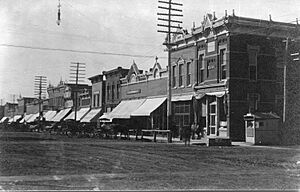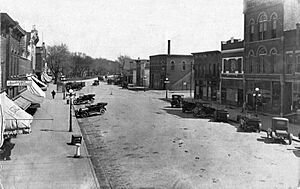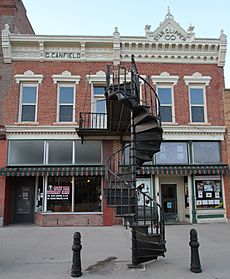Traer, Iowa facts for kids
Quick facts for kids
Traer, Iowa
|
|
|---|---|
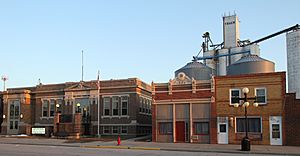
Downtown buildings including the Carnegie library and grain elevator
|
|
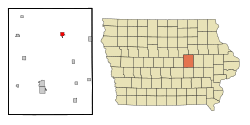
Location of Traer, Iowa
|
|
| Country | |
| State | |
| County | Tama |
| Area | |
| • Total | 1.29 sq mi (3.34 km2) |
| • Land | 1.29 sq mi (3.34 km2) |
| • Water | 0.00 sq mi (0.00 km2) |
| Elevation | 915 ft (279 m) |
| Population
(2020)
|
|
| • Total | 1,583 |
| • Density | 1,228.08/sq mi (474.02/km2) |
| Time zone | UTC-6 (Central (CST)) |
| • Summer (DST) | UTC-5 (CDT) |
| ZIP code |
50675
|
| Area code(s) | 319 |
| FIPS code | 19-78735 |
| GNIS feature ID | 0462294 |
Traer is a city located in Tama County, Iowa, in the United States. In 2020, about 1,583 people lived there.
Traer is famous for its unique iron spiral staircase. This special staircase used to lead to the local newspaper office. It's unusual because it stands on its own and has a walkway connecting it to the building.
Contents
History of Traer
The city of Traer began in 1873. This was after the Burlington, Cedar Rapids and Northern Railway built its tracks through the area. The city was named after John W. Traer.
Geography and Location
Traer is found in Perry Township. The city covers about 1.18 square miles (3.06 square kilometers) of land. There is no water area within the city limits.
Two important roads pass through Traer: U.S. Route 63 and Iowa Highway 8.
Population Changes Over Time
| Historical populations | ||
|---|---|---|
| Year | Pop. | ±% |
| 1880 | 1,100 | — |
| 1890 | 1,014 | −7.8% |
| 1900 | 1,458 | +43.8% |
| 1910 | 1,283 | −12.0% |
| 1920 | 1,329 | +3.6% |
| 1930 | 1,417 | +6.6% |
| 1940 | 1,493 | +5.4% |
| 1950 | 1,627 | +9.0% |
| 1960 | 1,623 | −0.2% |
| 1970 | 1,682 | +3.6% |
| 1980 | 1,703 | +1.2% |
| 1990 | 1,552 | −8.9% |
| 2000 | 1,594 | +2.7% |
| 2010 | 1,703 | +6.8% |
| 2020 | 1,583 | −7.0% |
| Source: and Iowa Data Center Source: |
||
The population of Traer has changed over the years. In 1880, about 1,100 people lived there. The population grew to 1,703 in 2010, but then decreased slightly to 1,583 by 2020.
What the 2020 Census Showed
In 2020, there were 1,583 people living in Traer. These people lived in 677 households, which are groups of people living together. About 418 of these households were families.
Most of the people in Traer (94.3%) were White. A small number were Black or African American (0.9%), Native American (0.4%), or Asian (0.4%). Some people (3.4%) identified with two or more races. About 1.5% of the population was Hispanic or Latino.
The average age in Traer was 45.8 years old. About 23.6% of the people were under 20 years old. Also, 25.9% were 65 years old or older. The city had slightly more females (52.8%) than males (47.2%).
What the 2010 Census Showed
In 2010, Traer had 1,703 residents. There were 693 households in the city. About 30.2% of these households had children under 18 living with them.
Most residents (98.0%) were White. Other groups included African American (0.2%), Native American (0.2%), and Asian (0.4%). About 0.8% of the population was Hispanic or Latino.
The average age in 2010 was 43.5 years. About 23.7% of residents were under 18. About 25.1% were 65 years old or older. The city had slightly more females (52.4%) than males (47.6%).
Education in Traer
Students in Traer attend schools that are part of the North Tama County Community School District.
City Services and Facilities
The city of Traer provides many services for its residents. These include a fire department to keep people safe and an ambulance service for emergencies. There is also a swimming pool for fun and exercise.
Traer has a public library where people can read and learn. The city also has an airport and two parks for outdoor activities.
Famous People from Traer
- James "Tama Jim" Wilson was an important person who lived in Traer. He served as the U.S. Secretary of Agriculture, which is a high-ranking government job. He was buried near Traer in 1920.
- Margaret Wilson was born in Traer. She was a writer who won the Pulitzer Prize for fiction in 1924. This is a very famous award for books.
See also
 In Spanish: Traer (Iowa) para niños
In Spanish: Traer (Iowa) para niños


